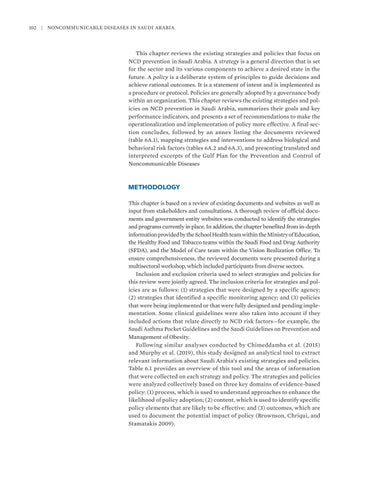102 | Noncommunicable Diseases in Saudi Arabia
This chapter reviews the existing strategies and policies that focus on NCD prevention in Saudi Arabia. A strategy is a general direction that is set for the sector and its various components to achieve a desired state in the future. A policy is a deliberate system of principles to guide decisions and achieve rational outcomes. It is a statement of intent and is implemented as a procedure or protocol. Policies are generally adopted by a governance body within an organization. This chapter reviews the existing strategies and policies on NCD prevention in Saudi Arabia, summarizes their goals and key performance indicators, and presents a set of recommendations to make the operationalization and implementation of policy more effective. A final section concludes, followed by an annex listing the documents reviewed (table 6A.1), mapping strategies and interventions to address biological and behavioral risk factors (tables 6A.2 and 6A.3), and presenting translated and interpreted excerpts of the Gulf Plan for the Prevention and Control of Noncommunicable Diseases
METHODOLOGY This chapter is based on a review of existing documents and websites as well as input from stakeholders and consultations. A thorough review of official documents and government entity websites was conducted to identify the strategies and programs currently in place. In addition, the chapter benefited from in-depth information provided by the School Health team within the Ministry of Education, the Healthy Food and Tobacco teams within the Saudi Food and Drug Authority (SFDA), and the Model of Care team within the Vision Realization Office. To ensure comprehensiveness, the reviewed documents were presented during a multisectoral workshop, which included participants from diverse sectors. Inclusion and exclusion criteria used to select strategies and policies for this review were jointly agreed. The inclusion criteria for strategies and policies are as follows: (1) strategies that were designed by a specific agency; (2) strategies that identified a specific monitoring agency; and (3) policies that were being implemented or that were fully designed and pending implementation. Some clinical guidelines were also taken into account if they included actions that relate directly to NCD risk factors—for example, the Saudi Asthma Pocket Guidelines and the Saudi Guidelines on Prevention and Management of Obesity. Following similar analyses conducted by Chimeddamba et al. (2015) and Murphy et al. (2019), this study designed an analytical tool to extract relevant information about Saudi Arabia’s existing strategies and policies. Table 6.1 provides an overview of this tool and the areas of information that were collected on each strategy and policy. The strategies and policies were analyzed collectively based on three key domains of evidence-based policy: (1) process, which is used to understand approaches to enhance the likelihood of policy adoption; (2) content, which is used to identify specific policy elements that are likely to be effective; and (3) outcomes, which are used to document the potential impact of policy (Brownson, Chriqui, and Stamatakis 2009).

